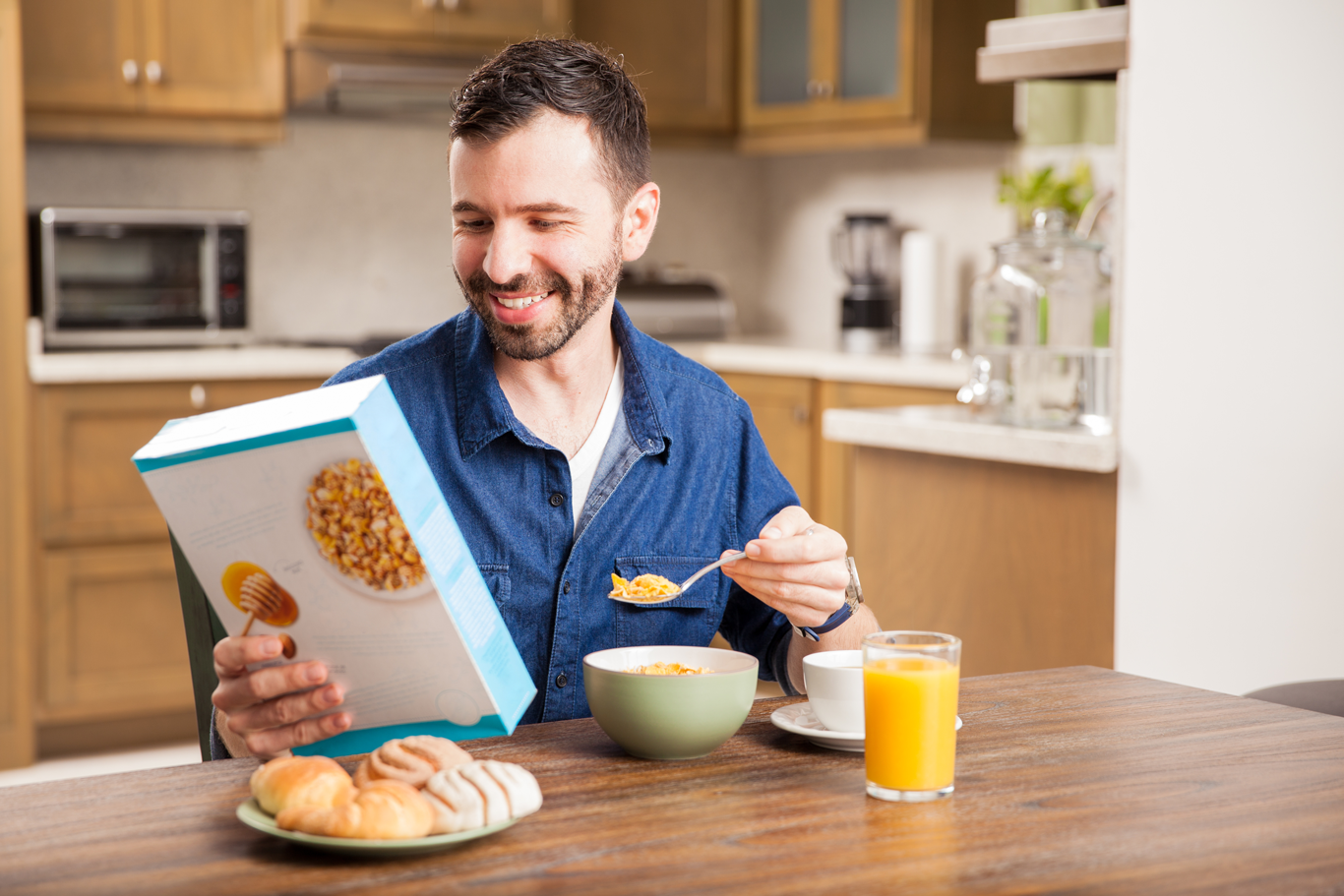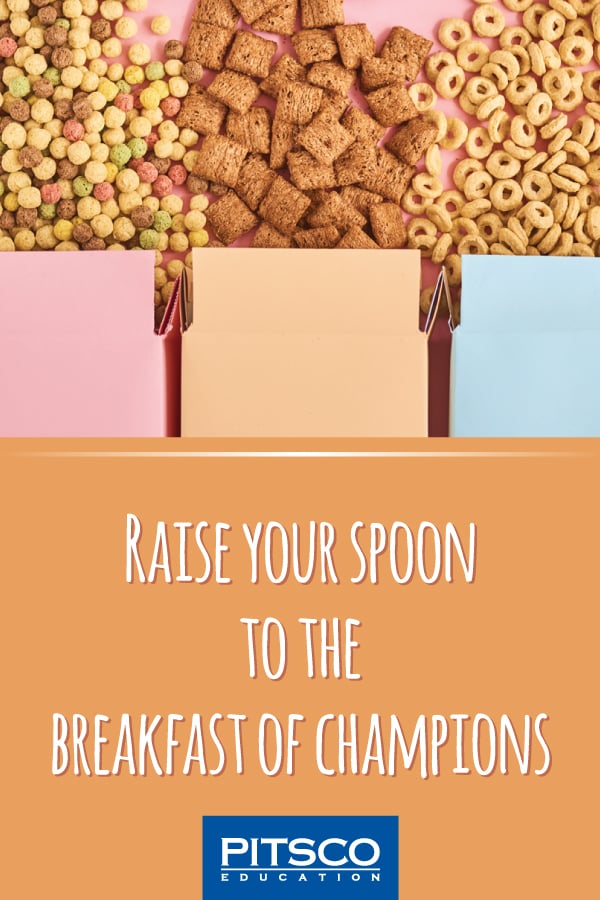Bowl? Check. Cereal? Check. Spoon? Check. Milk? Check. All the necessities for the most important meal of the day. National Cereal Day was March 7, and while we might be getting this to you a little late, we were just too busy separating Lucky Charms marshmallows from the frosted oats (not that we needed an excuse to enjoy the delicious, crunchy meal). Consider it an extended celebration 😉. Get on the grain train with us as we dive spoonfirst into some cereal-ously good breakfast history and the process it takes to make that perfect bowl.
While I was growing up, my parents didn’t buy us the fun, sugar-coated, chocolatey cereal unless it was a special occasion. My brothers and I would try and sneak it in the cart every grocery trip, but apparently, we weren’t sly enough because it never worked. Whenever we did get our hands on something other than fiber-loaded grains, we would treat ourselves to as many bowls as our stomachs could handle. To this day, I still crave the over-sugared and over-processed cereal. And I can’t say that I don’t struggle with keeping a box of cereal in my pantry without consuming it in a day. So, writing this blog about National Cereal Day seemed fitting.
America’s Favorite Breakfast
Being part of the Marketing department here at Pitsco, I decided to go against the grain to see how the advertising and messaging of cereal impacted society and why we really love it. Cereal has become the quintessential breakfast among Americans – I mean there’s a whole aisle dedicated to it. Americans go through more than three billion boxes of cereal every year, but how did cereal come to get its fame?
 Before cereal, people relied on soaking granola bits overnight – it was nowhere close to being as tasty as your DIY overnight oats. Wanting something tastier and easier, John Harvey Kellogg introduced the first ever ready-to-eat and no-soaking-needed cereal in the mid-1800s, which became Kellogg’s® Corn Flakes®. It was his brother Will, who later pushed to add sugar to the cereal mix, who created all the buzz. Soon enough, the cereal-inventing frenzy began; there were hundreds of cereal companies competing to be the #1 American breakfast (“Cereal: How Kellogg Invented a ‘Better’ Breakfast”).
Before cereal, people relied on soaking granola bits overnight – it was nowhere close to being as tasty as your DIY overnight oats. Wanting something tastier and easier, John Harvey Kellogg introduced the first ever ready-to-eat and no-soaking-needed cereal in the mid-1800s, which became Kellogg’s® Corn Flakes®. It was his brother Will, who later pushed to add sugar to the cereal mix, who created all the buzz. Soon enough, the cereal-inventing frenzy began; there were hundreds of cereal companies competing to be the #1 American breakfast (“Cereal: How Kellogg Invented a ‘Better’ Breakfast”).
Cereal was on the rise but became even more popular in 1944, when General Foods started a campaign called ‘Eat a Good Breakfast – Do a Better Job’. We can thank cereal marketers for creating the household phrase, “breakfast is the most important meal of the day.” And while this quote might be somewhat true, that’s a whole ’nother blog.
Cereal was easy, it was quick, and kids loved it! It didn’t take long before companies started marketing directly to the children. Creating fun cartoon characters with catchy slogans, adding prizes to the boxes (because what kid doesn’t need another toy?), and of course, another spoonful of sugar. Grocery stores would strategically put certain cereal boxes on the middle and lower shelves for kids to see. Companies went as far as designing their cereal boxes with the mascots’ gazes looking down to make eye contact with the kids – which psychologically can potentially increase trust. So, if you don’t want your kids to be “cuckoo for Cocoa Puffs,” I would recommend avoiding the cereal aisle (“Why Cereal Has Such Aggressive Marketing”)!
Bringing Science and Engineering to Your Table
I love cereal on those mornings when it seems there is never enough time to get ready. I throw some in a bowl, splash some milk, devour, and I’m out the door. To make cereal so easy for us to grab and eat, there’s a lot of work that goes on behind the scenes! Whether it’s a whole-grain or a flour cereal, they all start out as one or a mixture of these elements:
- Corn
- Wheat
- Oats
- Rice flours

A lot of cereals are cooked very similarly to how we cook popcorn. Popcorn for breakfast? It’s definitely not my choice for breakfast, but popcorn shares many of the same qualities as cereal. There is quite a bit of technology involved in the making of cereal to get that perfect crunch we love.
For the cereal lovers of Kellogg’s Corn Pops® or Honey Smacks®, the whole grains are cooked similar to using a pressure cooker. When they are fully cooked and the pressure is released, they will let out a POP! When the pressure drops suddenly, the moisture inside the grains is released as steam, which causes the grains to puff up. Each grain is then toasted, dried, and topped with sweeteners.
Other cereal such as Cheerios™ or Trix are made from a dough. This dough is a flour paste combined with sugar, water, coloring, and flavoring. After it’s mixed, this dough is sent through an extruder where the cereal pieces get their shape, similar to Pitsco’s Injection Molding Machine. After that, they are dried to the right moisture content and wait for the day they are poured into your bowl.
Flaked cereal, such as Frosted Flakes®, is made by using the starch from the grain. This starch is then cooked in water, sugar, salt, and the flavoring of your choice. After this is cooked, it is rolled to create individual flakes of cereal and toasted to perfection. Bon appétit (“The Fascinating Ways in Which Breakfast Cereals Are Made”).
Grrreat Ideas from the Box to the Classroom
Ready to take cereal beyond the bowl? We’ve found some pretty cool hands-on, minds-on activities that use cereal to teach a variety of concepts.
- Cereal Science Projects – Understand the basics of science by using cereal! Students can learn about electricity, absorption, movement of water molecules, and magnetism.
- Cereal Box Ramps – When you’ve finished your cereal, keep the box for an easy way to let kids explore physics and engineering. Let children design their own ramp using the cardboard box and get testing by sending differently sized objects down the track.
- Fruit Loop Graph – Sorting, graphing, and patterning! Grab those fun colored grains and some skewers for your students to design a real-life graph. And, of course, you can eat them when you’re done. That’s a win-win in my book!
- Eating Nails for Breakfast – Cereal is more than just wheat and corn; it contains iron as well! Using a strong magnet and your favorite cereal, explore how much metal might be sitting in your bowl.
- And, don’t forget to check out the backs of the cereal boxes! There might be puzzles, crosswords, or riddles to keep you entertained while you pour yourself a bowl of yum!

We are lucky to now have such a variety of cereals to choose from, and while Jolly Rancher cereal or Sour Patch Kids cereal might not be my first choice (yes, those are real), I love getting to celebrate the addicting grains. From watching Tony the Tiger® yell, “They’re grrreat!” to getting excited when I find a prize in a freshly opened cereal box, there’s something special about all the nostalgic feels. Grab your favorite cereal, slurp it up, and comment below about which cereal memory takes you back to your childhood.
Resources:
“Kid Tested. Marketing Approved. How Cereal Brands Target Children”
“The Fascinating Ways In Which Breakfast Cereals Are Made”
“Why Cereal Has Such Aggressive Marketing”
“Cereal: How Kellogg Invented a ‘Better’ Breakfast”

TOPICS: IN THE CLASSROOM, BEYOND THE CLASSROOM, IDEAS & INSPIRATION, News, Science, STEM, Trends, Resources, Activities, Hands-on Learning, STEAM



